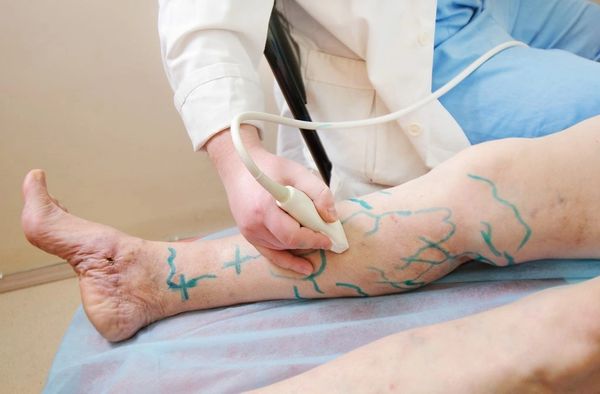VARICOSE VEINS

Varicose veins or varicosities, are bulging , twisted superficial veins that lie just under the skin. Varicose veins most often affect the veins in the legs because standing and walking increase the pressure in the veins of the lower body, causing them to stretch. When the valves in the veins become stretched or weakened or damaged, blood can collect in the veins. For many people, varicose veins such as spider veins, are simply a cosmetic concern. But varicose veins can cause more serious health conditions such as aching pain and discomfort, itching, skin discoloration, blood clots, bleeding, ulcers and chronic swelling. Stateline specializes in treating the entire spectrum of venous insufficiency.
Treatment

Sclerotherapy
Sclerotherapy is a common method of eliminating varicose and spider veins in which a solution, called a sclerosing agent, is injected into the veins. It causes an inflammatory reaction that closes the vein. The treated veins then fade over a period of weeks to months. Most persons who have sclerotherapy performed will see clearing or at least see a significant improvement in the reduction of leg veins (85% improvement is considered the "industry standard"). A small percentage of patients who undergo sclerotherapy have fair to poor results and in rare instances, the patient's condition may become worse after sclerotherapy treatment. The number of treatments needed differs from patient to patient, depending on the extent of the problem.

Ultrasound-Guided Sclerotherapy
Ultrasound-guided sclerotherapy using microfoam is a minimally invasive option for treating larger truncal and tributary varicose veins. The first stage of the procedure will involve inserting a catheter or needle into the vein under ultrasound guidance. Your leg may be anesthetized with a local anesthetic agent, lidocaine. During the second stage of the treatment, the microfoam is injected through the catheter or needle under ultrasound guidance. This will cause the vein to spasm and close, decreasing the venous insufficiency within the leg.

Endovenous Ablation
Radiofrequeny Ablation:
Radiofrequency ablation (RFA) for varicose veins is a minimally invasive procedure that uses heat generated by radiofrequency energy to seal off enlarged leg veins, effectively treating varicose veins by collapsing the vein walls and preventing blood from flowing through them, causing them to shrink and disappear over time;
This procedure is performed under local anesthetic. Ultrasound guidance is used to precisely locate the vein. A small incision is made near the affected vein through which a catheter is inserted into the vein and advanced to the targeted area. Radiofrequency energy is delivered to the vein wall, causing it to collapse. The catheter is slowly withdrawn, treating the entire length of the vein. Compression stockings are usually worn for a period following the procedure to support the treated veins. Most patients can resume normal activities within a few days. It is a highly effective treatment for varicose veins with good cosmetic results and minimal scarring.
Cyanoacrylate glue ablation:
Cyanoacrylate ablation for incompetent saphenous veins does not require the instillation of tumescent anesthesia during the procedure, thus reducing patient discomfort, and neither are compression hose necessary after treatment. It is designed to close diseased veins with a medical adhesive delivered through a small catheter.

Ambulatory Phlebectomy
Phlebectomy is a minimally invasive surgical technique to remove varicose veins.
During a phlebectomy several tiny cuts (incisions) are made in the skin through which superficial bulging varicose veins are removed. Phlebectomy is ideal for bulging varicose veins that are close to the surface of the skin and are too large for sclerotherapy.
Stateline Health
435 Commonwealth Boulevard East, Martinsville, Virginia 24112, United States
276-403-4278 fax: 276-403-4283
Copyright © 2025 Stateline Health - All Rights Reserved.
Created by SiteSculptorsMVA
This website uses cookies.
We use cookies to analyze website traffic and optimize your website experience. By accepting our use of cookies, your data will be aggregated with all other user data.
